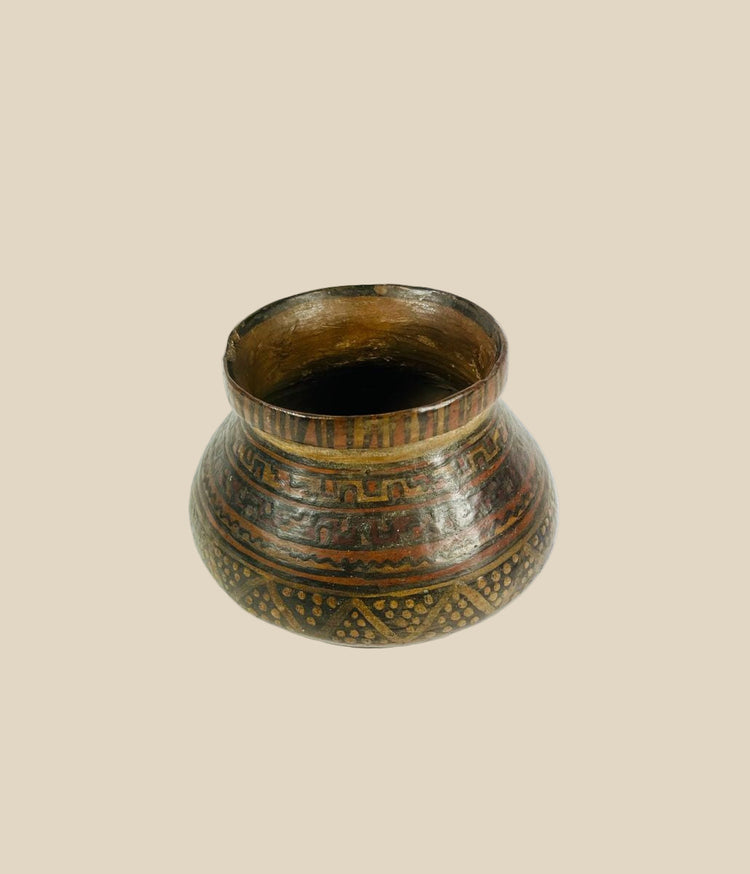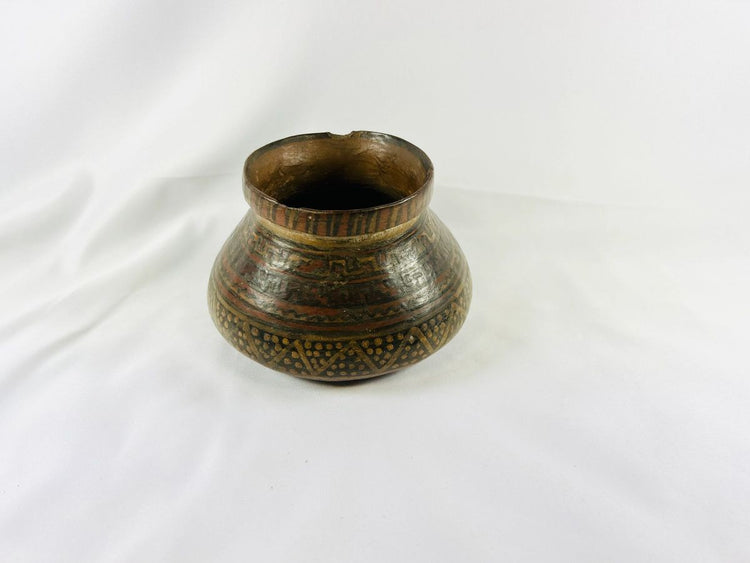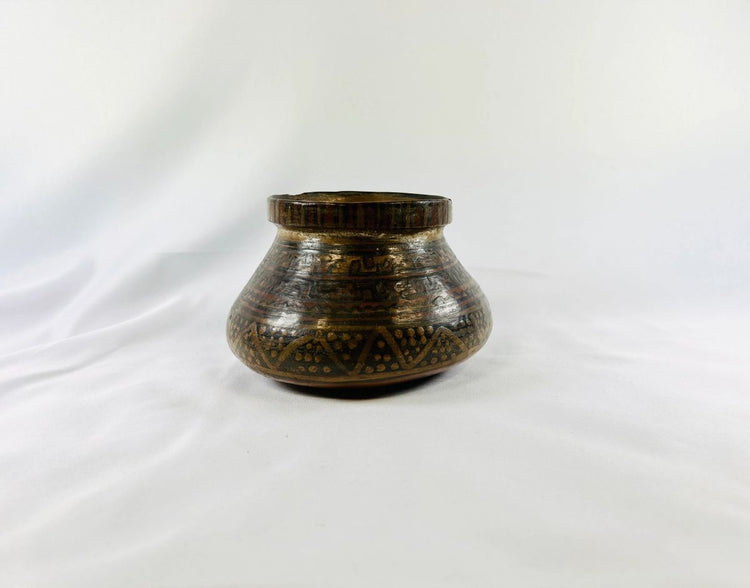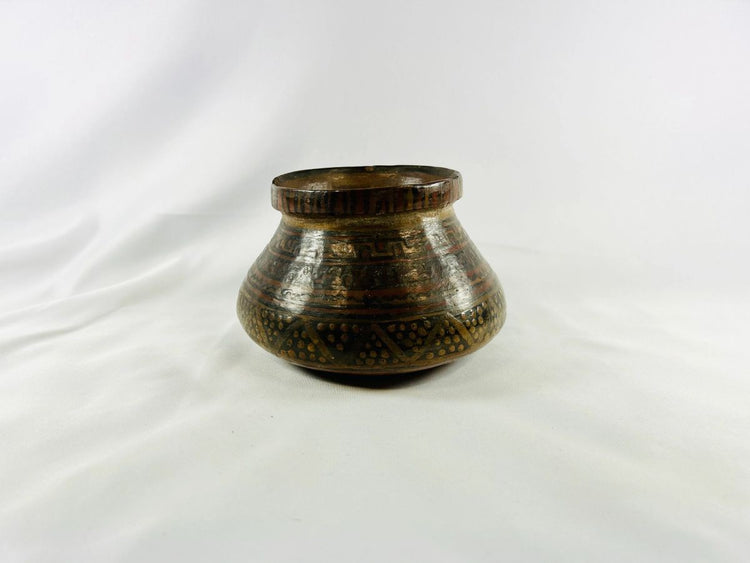Pre-Columbian Mesoamerican Pottery | Ritual and Utilitarian Ceramics | Circa 1500 BCE – 1521 CE
Description
More
Less
Historical Context & Origin
Region: Mesoamerica (Northern Mexico to Guatemala and Honduras)
Material: Ceramic (monochrome and polychrome)
Period: Pre-Columbian (Olmec to Aztec, circa 1500 BCE – 1521 CE)
Description
Mesoamerican pottery represents one of the most advanced and enduring traditions of pre-Columbian art. Produced in a wide range of forms—bowls, plates, and cylindrical vessels—ceramics served both practical and ceremonial purposes. Utilitarian wares were typically monochrome and functional, while elite vessels were intricately painted with mythological scenes, glyphs, and ritual imagery. Polychrome examples, requiring advanced slip and firing techniques, were highly prized by nobility as symbols of wealth, prestige, and sacred power.
Features
- Wide diversity of vessel forms: bowls, plates, and cylindrical drinking cups
- Utilitarian monochrome wares for storage and daily use
- Polychrome vessels with mineral slips, complex firing, and detailed iconography
- Decorative motifs featuring deities, glyphs, courtly rituals, and mythological narratives
- Highly valued by elite households as both functional objects and diplomatic gifts
Cultural Significance
Ceramics in Mesoamerica were more than utilitarian objects—they were vehicles of cultural expression, storytelling, and status. Polychrome pottery, in particular, was used in feasts, religious ceremonies, and royal tombs, serving as both sacred offerings and markers of social hierarchy. As portable works of art, these vessels reinforced connections between daily life, cosmology, and ritual practice, offering a direct link to the beliefs and values of civilizations such as the Maya, Mixtec, and Aztec. Today, they provide archaeologists and collectors alike with critical insight into pre-Columbian society, economy, and worldview.
Condition
Surviving examples exhibit natural surface wear and soil encrustations consistent with archaeological recovery, with many retaining vibrant slips and detailed painted decoration.
Dimensions (approximate)
Height: 3.9 in
Diameter: 5.4 in
Age
Pre-Columbian (circa 1500 BCE – 1521 CE)
Learn More
Explore the artistic traditions and ceramic innovations featured in past museum exhibitions on ancient Mesoamerican cultures: Mesoamerican Ceramics Exhibition – University of Richmond Museums
Browse additional authentic Mesoamerican artifacts, pottery, and Pre-Columbian relics available in our curated collection: Mesoamerican Artifacts & Ceramics – Relic And Rarity
Description
Historical Context & Origin
Region: Mesoamerica (Northern Mexico to Guatemala and Honduras)
Material: Ceramic (monochrome and polychrome)
Period: Pre-Columbian (Olmec to Aztec, circa 1500 BCE – 1521 CE)
Description
Mesoamerican pottery represents one of the most advanced and enduring traditions of pre-Columbian art. Produced in a wide range of forms—bowls, plates, and cylindrical vessels—ceramics served both practical and ceremonial purposes. Utilitarian wares were typically monochrome and functional, while elite vessels were intricately painted with mythological scenes, glyphs, and ritual imagery. Polychrome examples, requiring advanced slip and firing techniques, were highly prized by nobility as symbols of wealth, prestige, and sacred power.
Features
- Wide diversity of vessel forms: bowls, plates, and cylindrical drinking cups
- Utilitarian monochrome wares for storage and daily use
- Polychrome vessels with mineral slips, complex firing, and detailed iconography
- Decorative motifs featuring deities, glyphs, courtly rituals, and mythological narratives
- Highly valued by elite households as both functional objects and diplomatic gifts
Cultural Significance
Ceramics in Mesoamerica were more than utilitarian objects—they were vehicles of cultural expression, storytelling, and status. Polychrome pottery, in particular, was used in feasts, religious ceremonies, and royal tombs, serving as both sacred offerings and markers of social hierarchy. As portable works of art, these vessels reinforced connections between daily life, cosmology, and ritual practice, offering a direct link to the beliefs and values of civilizations such as the Maya, Mixtec, and Aztec. Today, they provide archaeologists and collectors alike with critical insight into pre-Columbian society, economy, and worldview.
Condition
Surviving examples exhibit natural surface wear and soil encrustations consistent with archaeological recovery, with many retaining vibrant slips and detailed painted decoration.
Dimensions (approximate)
Height: 3.9 in
Diameter: 5.4 in
Age
Pre-Columbian (circa 1500 BCE – 1521 CE)
Learn More
Explore the artistic traditions and ceramic innovations featured in past museum exhibitions on ancient Mesoamerican cultures: Mesoamerican Ceramics Exhibition – University of Richmond Museums
Browse additional authentic Mesoamerican artifacts, pottery, and Pre-Columbian relics available in our curated collection: Mesoamerican Artifacts & Ceramics – Relic And Rarity
You May Also Like

















